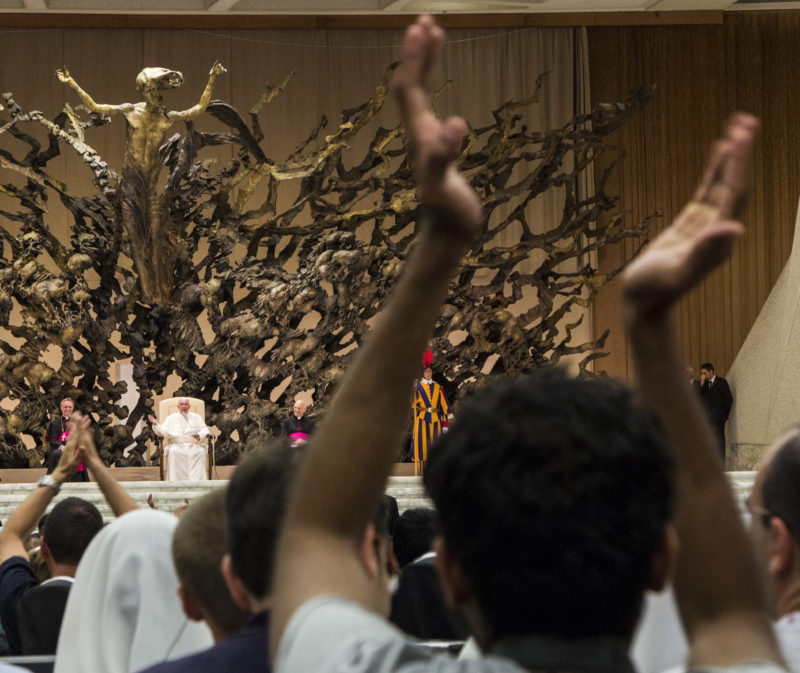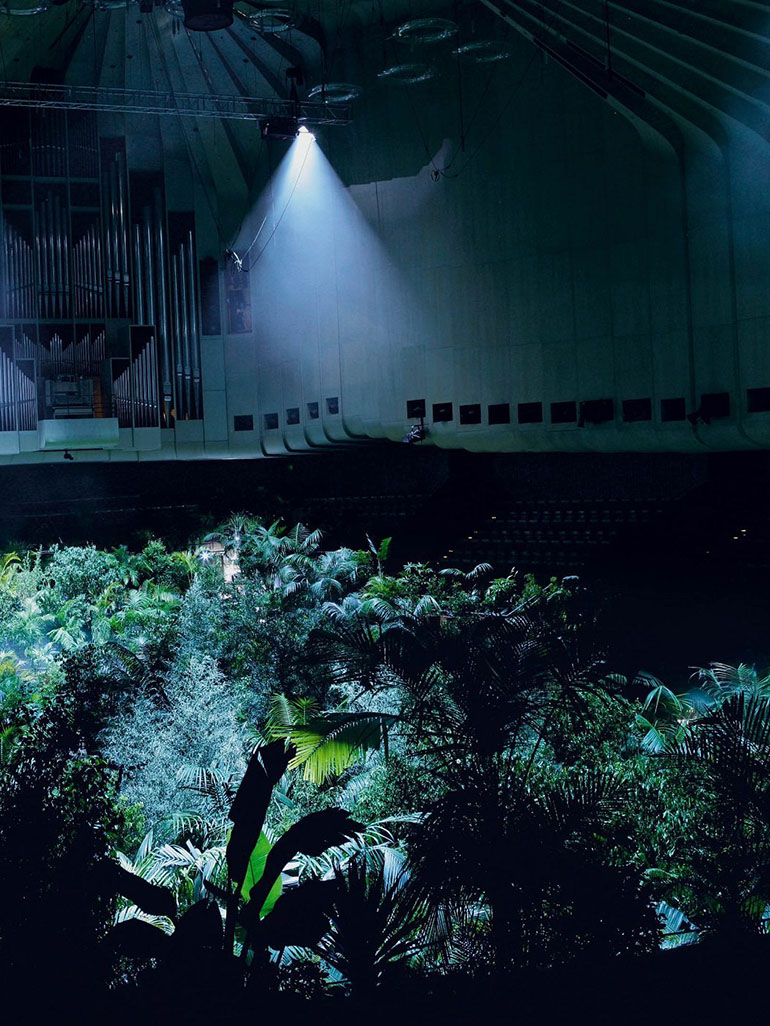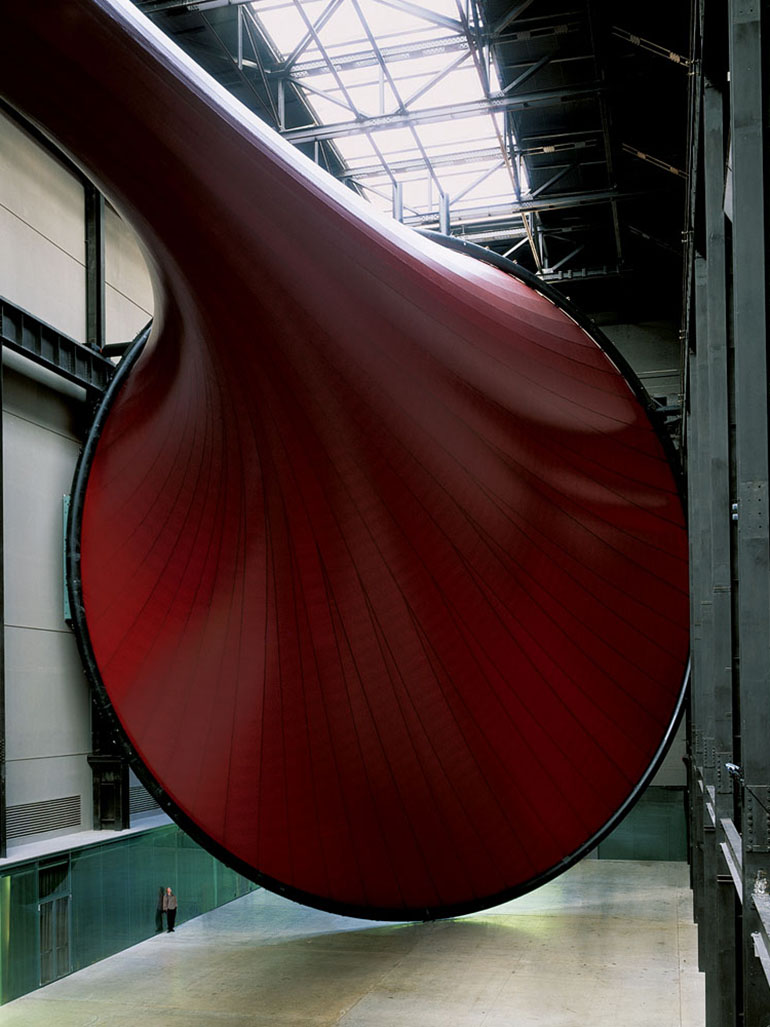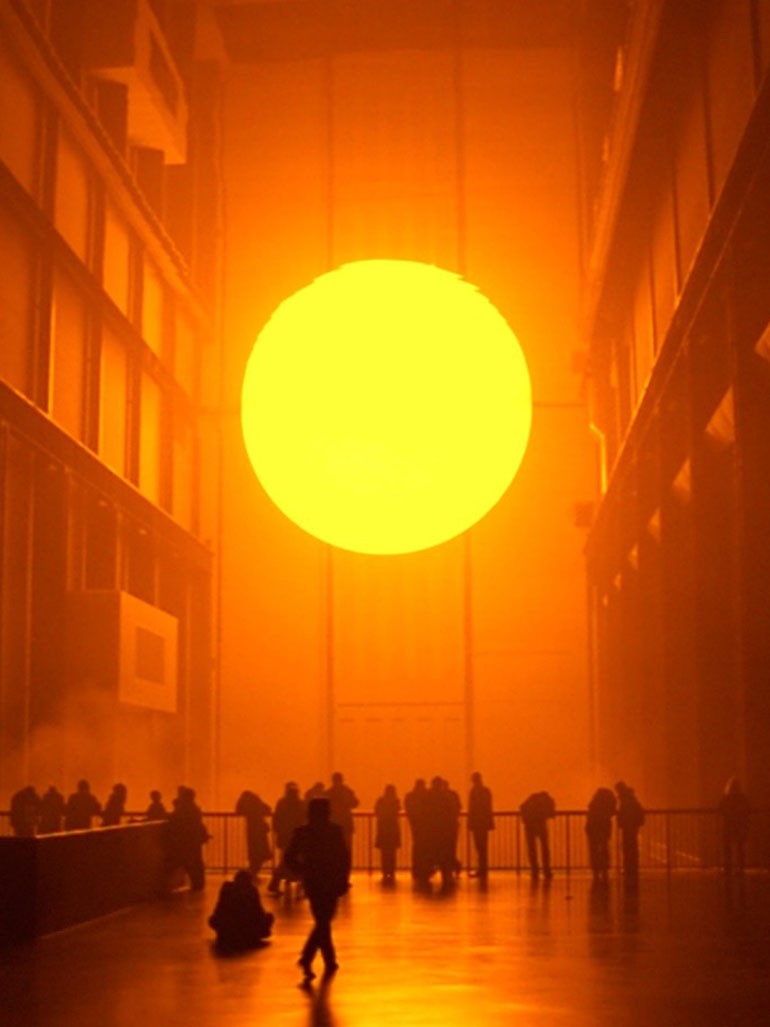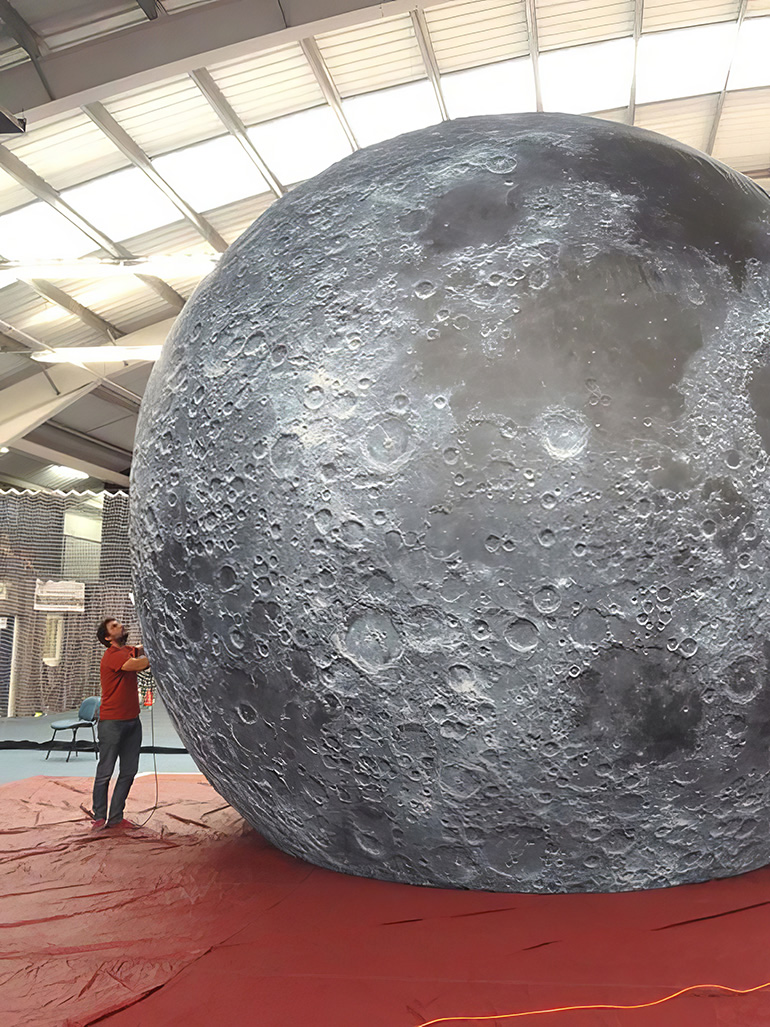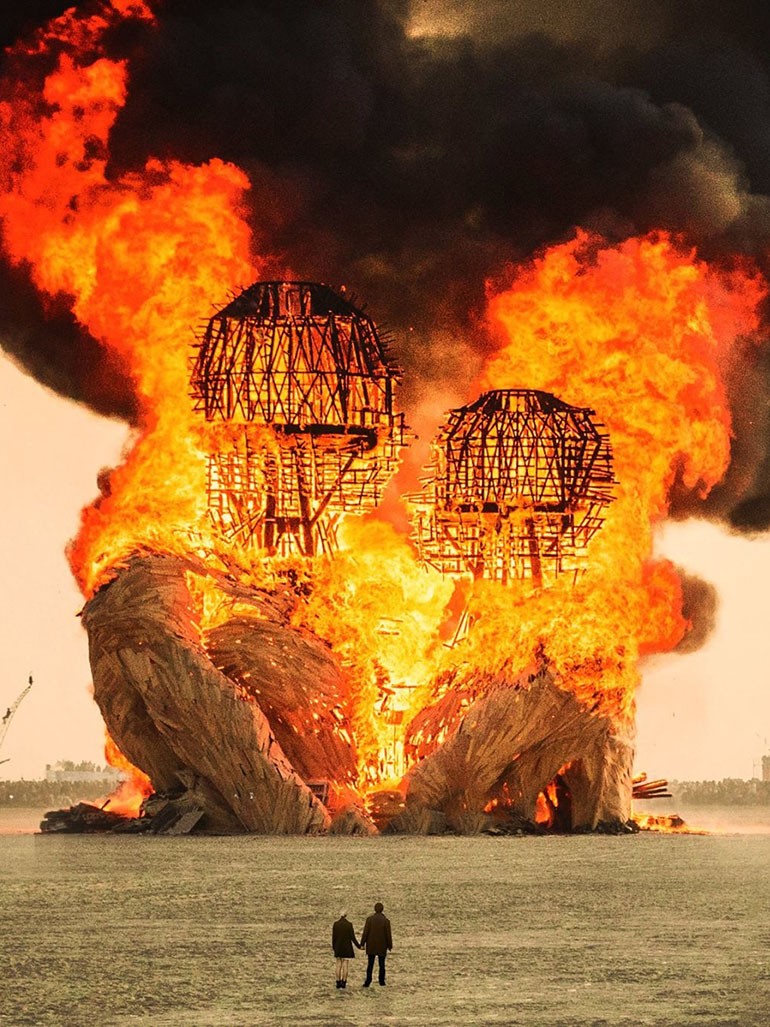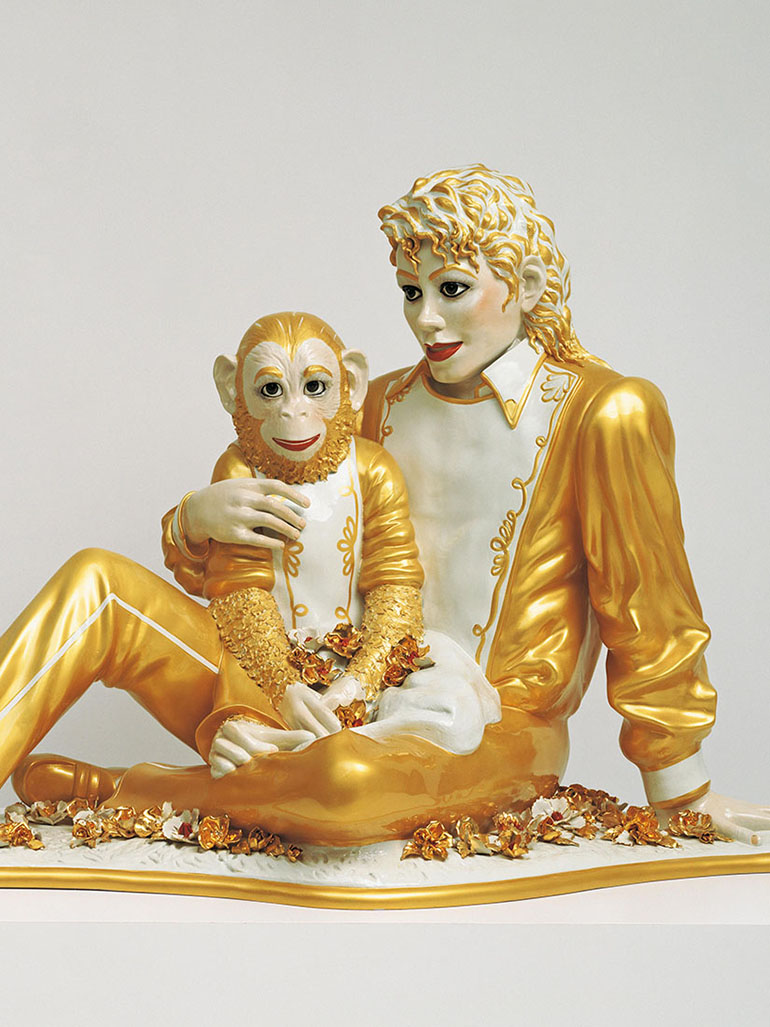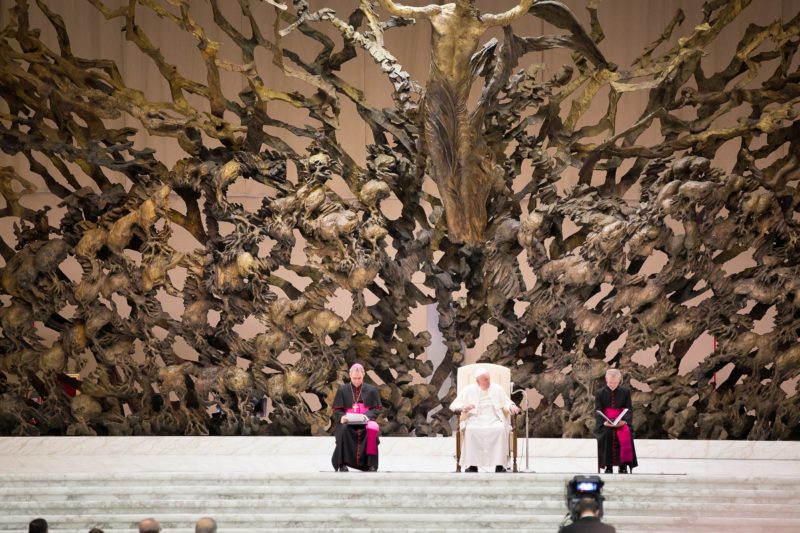
Introduction
Ever heard about the ‘demonic’ idol in the Vatican? Well, this refers to the large modern sculpture depicting the resurrection of Jesus, a backdrop work of art behind the stage in Paul VI Audience Hall.
The Paul VI Audience Halls draws many conspiracy theories not only due to this sculpture that people swear is a demonic representation and a serpent idol, but also because the design of the hall makes many associate it with snake imagery.
The hall is where the pope holds his weekly audiences with believers when the weather is not suitable for outdoor audiences at St. Peter’s Square.
Back to the sculpture, what is it and why do people associate it with serpents and demons?
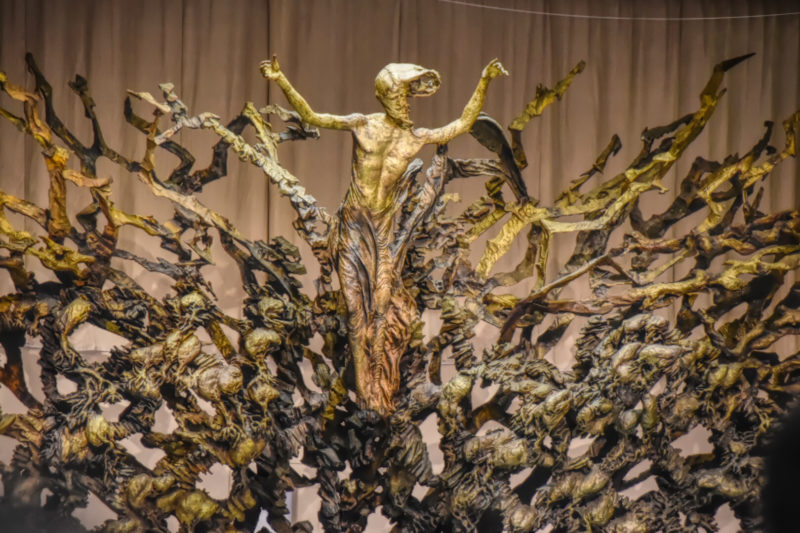
The Resurrection is a colossal sculpture created by Pericle Fazzini and measures an impressive 66-ft by 23-ft by 10ft. It depicts Jesus rising from the crater of a nuclear bomb in the Garden of Gethsemane.
In 1964 well-known engineer and architect Pier Luigi Nervi was appointed by Paul VI to create an audience hall, now known as the Paul VI Hall. Construction started in 1966 and the building was inaugurated in 1971.
Fazzini first communicated with the Vatican in 1965, but it was not until 1972 when he was finally commissioned to create the Resurrection after Pope Montini intervened.
The artist began working in 1970, created the final sketch in 1975 and completed the entire work in 1977 when it was inaugurated on the Pontiff’s eightieth birthday. Casting was done at the Michelucci Art Foundry in Pistoia, where it was molded in red bronze and yellow brass.
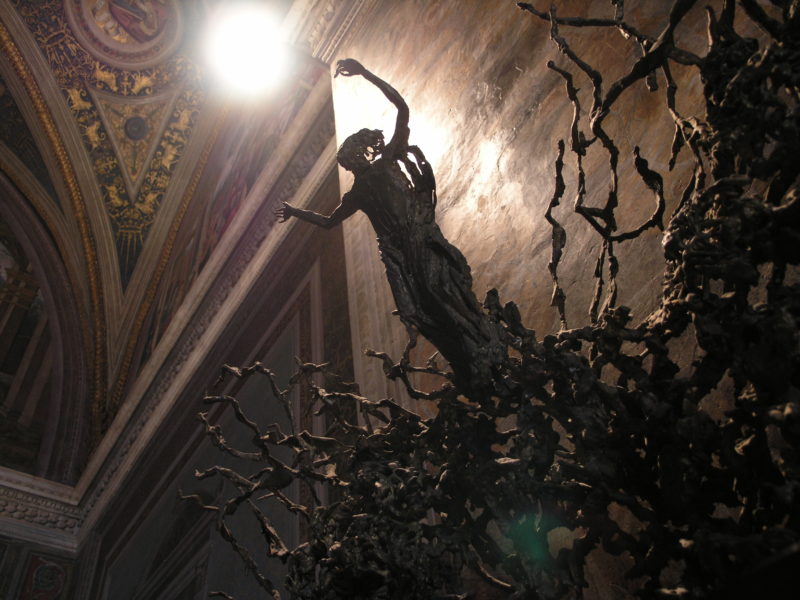
Being situated as it is at the most prominent place in Paul VI Audience Hall is a way to remind the audience that as Christians, they should not fear the second coming of Jesus Christ. Instead, they should be aware that their pilgrimage and faith in this world is a continuous Advent. It lifts them up to reach the definitive encounter with Jesus Christ.
Indeed, The Resurrection mirrors the fatalistic touch that surrounds all thought of the second coming of Jesus Christ. When Christians think of the Second Coming of Christ, there is something awe-inspiring about this event.
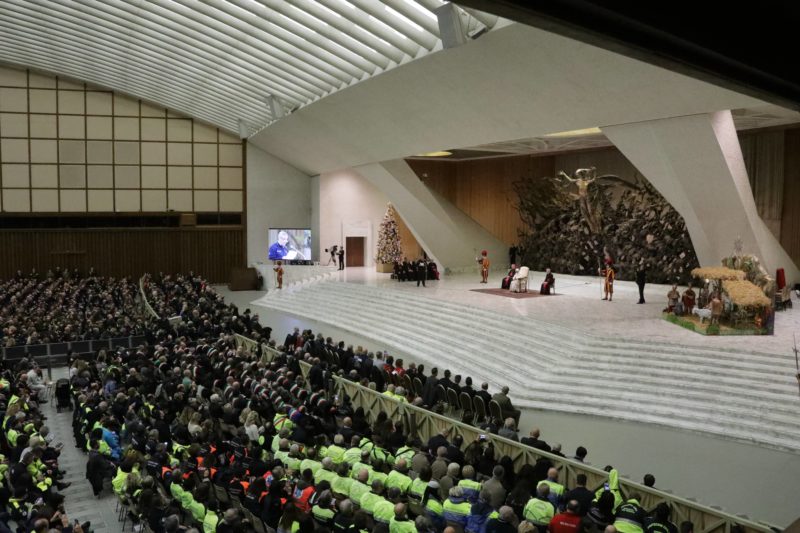
What it shows
Occupying the entire middle section of the wall behind the stage, at its center is the risen Christ, majestically soaring amidst the chaos that tells of death. He has long hair and a beard that both look like they are being moved about by the wind; his face has the look of inner pain.
The chaos is represented through the collection of natural elements fused with each other though they are not well defined. These depict rocks, roots and twigs.
The sculpture’s uncomfortably contorted shapes that depict the chaos from which a rising Christ emerges is fitting of the great event of which it tries to portray.
It looks scary because it is meant to be scary.
After all, rising from a nuclear bomb crater can hardly be considered a calm and passive endeavor.
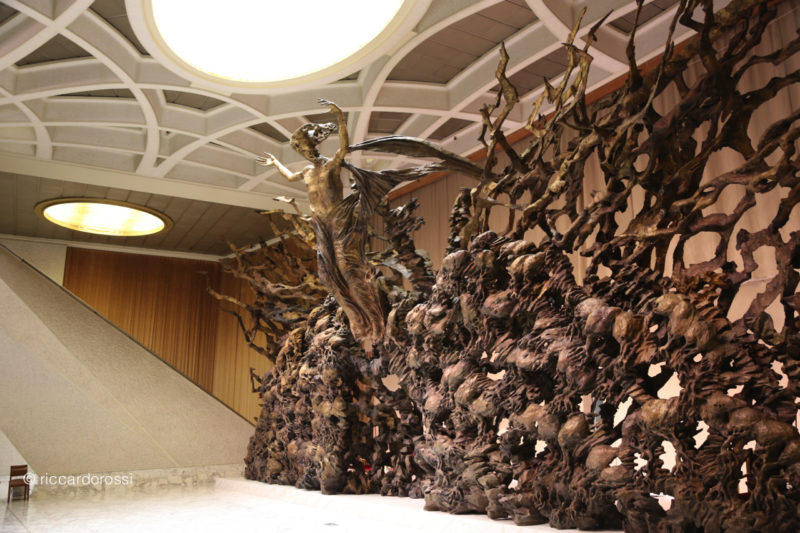
However, there is hope in the second coming of Christ. It shows in the way he has lifted and opened his arms in a seeming welcome to the masses in the hall. His long hair and beard moved by the wind also soften his appearance, even depicting this gloomy scene.
Fazzini described the moment as follows1:
An explosion from the earth, with olive trees in the air, stones, clouds, lightning bolts … like an enormous storm in the form of the world and Christ who rises serenely from all of this.
The rest of the creepy sculpture, a collection of indefinite natural elements fused together such as twigs, roots and rocks that come from the vortex that previously was the Garden of Gethsemane, show that through the chaos, there is hope emerging.
Jesus is radiant even though there is pain on His face. Pope Benedict XVI calls this ‘the evolutionary leap’ of the Resurrection when explaining how the second coming of Christ will give human existence a new dimension.
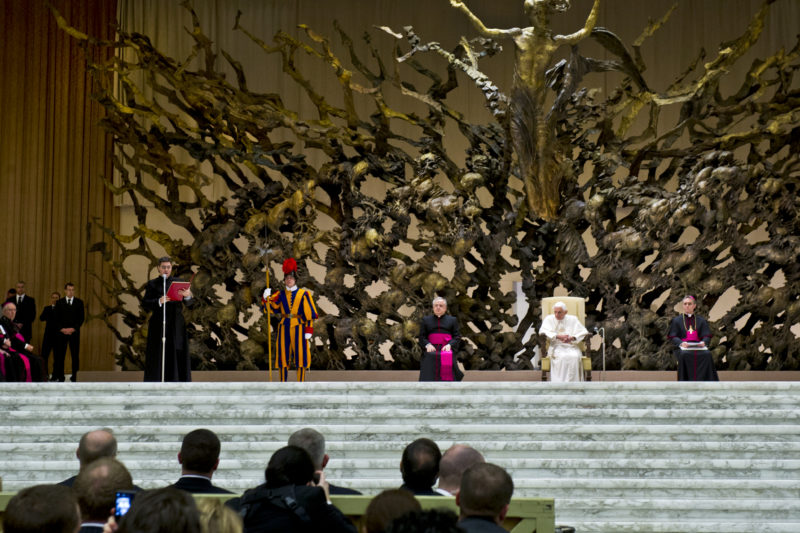
Inspiration
According to Fazzini, the inspiration to create this artwork was because he pictured the idea of Christ preaching peace for two millennia in the place where he last played – the olive grove of Gethsemane. He then conceives the moment of the Resurrection as an explosion from the earth that disrupts the garden as such following in the New York Times2:
I had the idea of depicting Christ as if He were rising again from the explosion of this large olive grove, peaceful site of His last prayers. Christ rises from this crater torn open by a nuclear bomb; an atrocious explosion, a vortex of violence and energy.
To communicate this idea, Fazzini first presented a full-sized prototype of the entire sculpture. He made it by using polystyrene, forming the complex and compositional structure with the help of electrical hotkeys. Unfortunately, the creation of the polystyrene sculpture gave Fazzini a blood clot due to the fumes from the burning plastic.
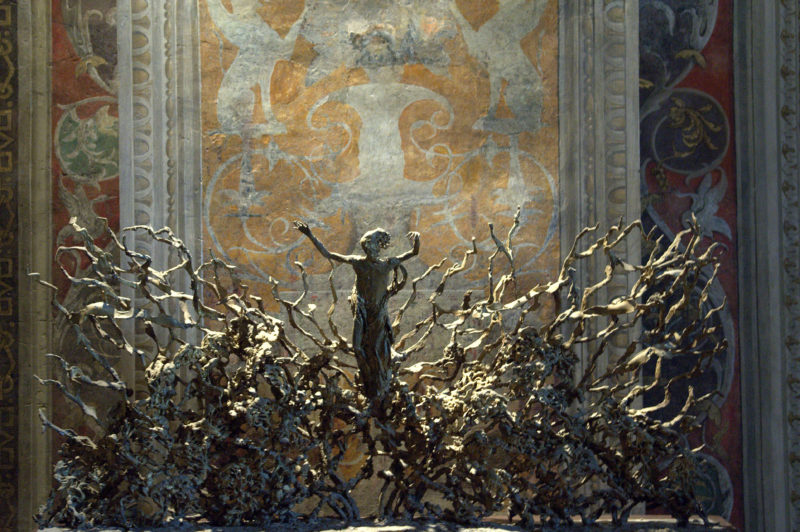
The meaning
The 8-metric ton sculpture was also intended to capture the anguish of the state of the world at the time. In the 1960s and 1970s, mankind was living under the threat of nuclear war and under a tenuous peace that had tensions among the Western countries especially.
Under the threat of a nuclear war of apocalyptic proportions, it is not surprising that this was depicted in various artworks formed around this period. La Resurrezione thus is an apt depiction of the second coming of Jesus that shows him rising from a nuclear crater. At the time, it was very possible to think that if the world were to end then, this would be a result of atomic forces.
As such, it is far from beautiful and calming and instead is ominous as it tries to capture the tension and anticipation of destruction that characterized the times. Christ emerges from indefinite chaos that is meant to represent the death and destruction from atomic forces.
In fact, before the Renaissance period, many artworks were represented in spiritual form instead of depicting real life. However, later, artists began using imagery that showed real life and the times they were living in.
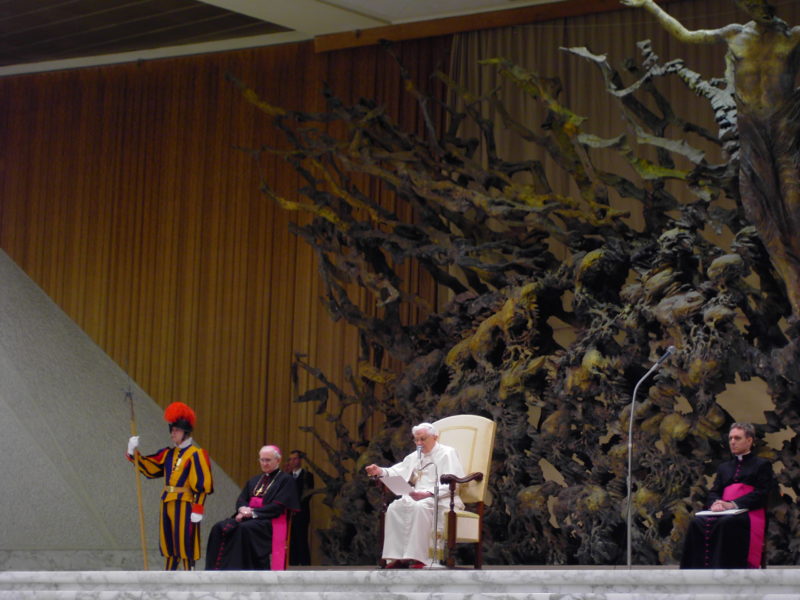
Analysis
When you think of artworks with religious connotations, it makes sense why they would feature themes linked to the condition of mankind. Therefore, the artist often places themselves in the presence of pain and has the desire to have the answers or give the answer to the question of existence, death, resurrection, etc.
Fazzini drew from the nuclear tension-filled landscape of the Cold War era and used it to give meaning to the obscure event that is the resurrection of Christ. The resulting picture is disturbing and problematic.
The sculpture reflects the situation of a secularized and fearful era where the world’s emerging superpowers have it under the threat of a nuclear war of epic apocalyptic proportions. This sculpture thus may cause discomfort among viewers even at the time the fatalistic theme was too close to reality.
While the rising Christ is meant to be a soothing figure for Christians in the face of the chaos, at the time, it must have also induced fear, knowing that the threat of the world ending fatally was very real. It thus assumed a Biblical sense of prophecy frighteningly similar to what is described in the book of Revelations and drawing from the situation that was ongoing in real life.
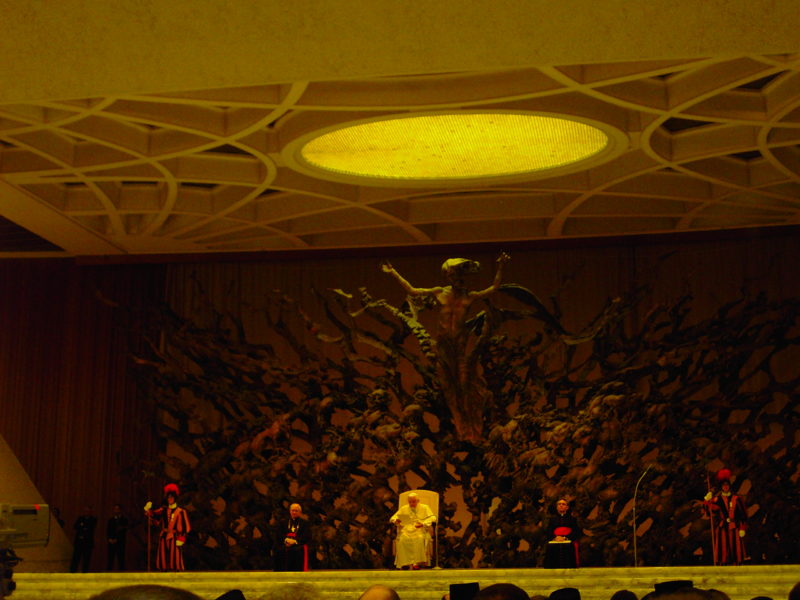
Though mankind has gone past the state of tension and fear that characterized the Cold War Era, there are many other hopeless and seemingly destructive events and disasters that humans experience.
These form the basis of the chaos from which one can find hope, such as in the case of the rising Christ, emerging from the chaos of destruction and death. As such, while the sculpture may be ominous and inspire discomfort, it is also a reminder of the hope that one gets if they put their faith in Christ.
The artist here plays the role of a protagonist who uses different themes, ideologies, styles and imagery to give hope to those shackled by the violence and fear that characterizes the world.
This sculpture thus is, in essence, a crying defense of mankind by depicting the dawn of the second coming of Christ that even though he goes through agony in emerging from the destruction caused by humans upon themselves, he is ready to show compassion and give hope to the same humans.
This shows the inherent moral strength that Christ possesses and is a reminder that we should try to emulate the same. And since artists are able to reflect the situation at the time of creating their work, it is only natural that Fazzini chose to depict the season at the time just like other artists drew from seasons in real life such as the genocides, war, concentration camps, technological advancements, etc.
These artists do not allow themselves to be gagged and choose to represent real life as they fit, and in this case, Fazzini excelled at it.
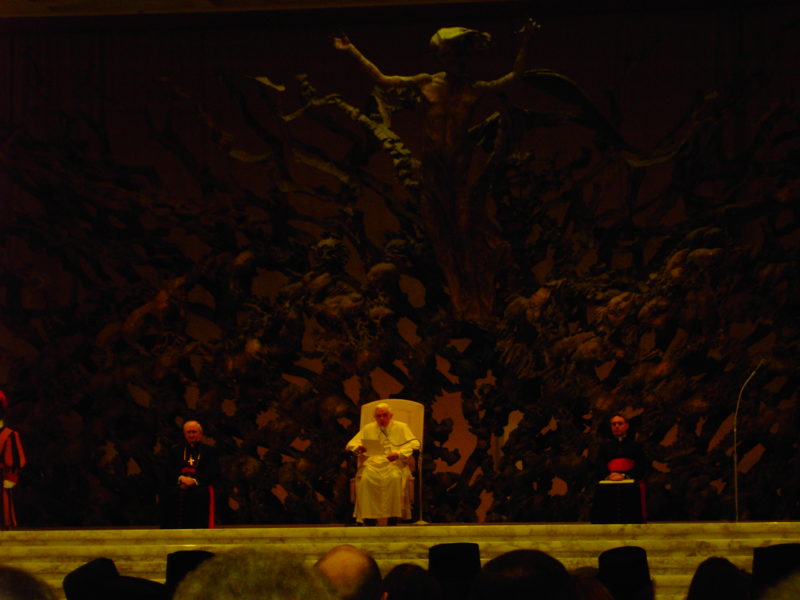
The Resurrection mirrored
Therefore, the weird appearance of the 66-foot by 23-foot sculpture has spawned several conspiracy theories. According to some of the conspiracy aficionados, the statue depicts Baphomet, a deity that the Knights Templar allegedly worshiped and became the main symbol and idol in the occult, pop star art and Illuminati symbolism.
The conspiracy theories claim that if you view the Resurrection statue at its right-hand side as in a mirror, you can clearly see Baphomet’s head which is in the shape of a goat staring back at you. This is just one of the many conspiracy theories that surround the sculpture.
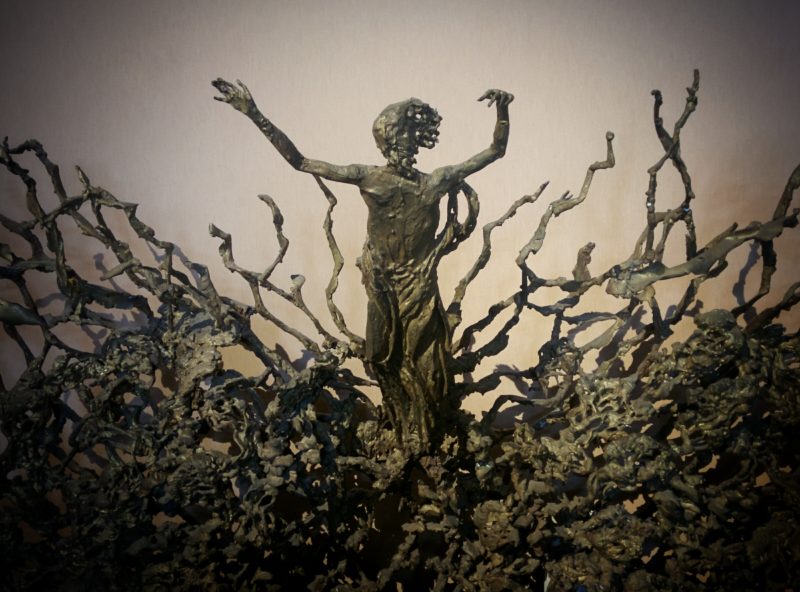
Restoration of The Resurrection
Pericle Fazzini’s sculpture was cleaned and restored in 2011 over the course of three months when the weather was warm such that the pope’s general audience could be held outdoors at St. Peter’sSquare.
To restore the intricate sculpture, the process was started by a preliminary analysis comprising a visual material analysis and a scientific analysis to determine the degradation factors and plan for the operational intervention on the work.
Also, a diagnostic examination to show the state of conservation of the sculpture was carried out and thus showed that the external parts of the artwork had deposits of dust, grease and atmospheric particulate matter, as well as pervasive oxidation, typical of copper.
After this was determined, an intervention methodology was designed to achieve the desired technical and aesthetic requirements. This process was then carried out in scheduled stages to remove the surface deposits and give back the statue its original brilliance.
Artist’s short bio
Pericle Fazzini (1913-1987) was a celebrated Italian sculptor. His works are in major private collections as well as in many museums around the world such as the National Gallery of Modern Art in Rome, the Tate Gallery in London, Hakone Open Air Museum in Japan, the MOMAT of Tokyo, Museum of Contemporary Art in Montreal and the Art Institute of Chicago among others.
He was born on May 4, 1923, at Grottammare in Ascoli Piceno in the Marche, one of the twenty regions of Italy. He learned wood carving at his family’s carpentry shop at a young age and later studied in Rome.
Described by writer Giuseppe Ungaretti as the ‘poet of the wind‘3, Fazzini was well renowned for his work and thoughts. He won several prestigious contents and exhibited his sculptures at important art spaces throughout his life.
He was described as such because he was interested in and produced portraiture artworks with a subtle infusion of a sense of humanity. Later, he returned to a more Baroque sensibility, combining figures and inspiration from fantasy and real-life alike and featuring a sense of dynamic visual rhythm in his work.
It can be said that just like Jesus rises in his sculpture, even after his death in 1987, Fazzini’s art still lives on, and his works still spread the energy that continues to renovate human beings.

Final words
While the Vatican’s Resurrection sculpture is not to everyone’s tastes, it is definitely worth seeing, if only to debunk the myth of Serpent imagery yourself. Indeed, art lovers are drawn to the statue because it strikes a delicate balance between classical beauty exemplified by Renaissance ideals and naturalism.
For many, the second coming of Jesus is something they fantasize about as being a source of comfort and hope. However, this also has a fatalistic or gloomy touch as this might be as a result of the world ending. As such, The Resurrection is built on these themes around the second coming of Jesus.
All in all, while conspiracy buffs have tried to assign all manner of meaning to The Resurrection, these do not hold any water. The original artist’s intention is quite clear that it is a depiction of Jesus rising from a nuclear Armageddon.
It depicts real-life intertwined with the doctrines of Christianity and Catholicism, resulting in a piece of sculptural art that is impressive and striking. It is meant to be powerful and overwhelming as we imagine how the actual coming of Christ will be.
